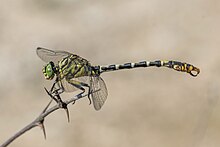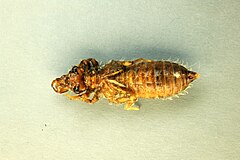
Odonata is an order of flying insects that includes the dragonflies and damselflies.

The blue-tailed damselfly or common bluetail is a damselfly, belonging to the family Coenagrionidae.

The Gomphidae are a family of dragonflies commonly referred to as clubtails or club-tailed dragonflies. The family contains about 90 genera and 900 species found across North and South America, Europe, Asia, and Australia. The name refers to the club-like widening of the end of the abdomen. However, this club is usually less pronounced in females and is entirely absent in some species.

Onychogomphus is a genus of dragonflies in the family Gomphidae. They are commonly known as pincertails.
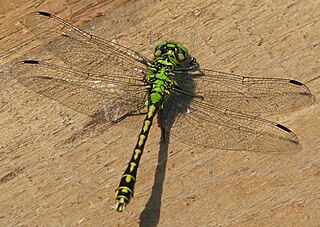
Ophiogomphus cecilia, the green snaketail, green gomphid, or green club-tailed dragonfly, is a species of dragonfly in the family Gomphidae.
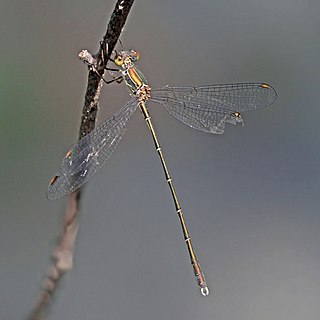
Chalcolestes parvidens, formerly Lestes parvidens, is a damselfly of the family Lestidae. It has a metallic green body and at rest it holds its wings away from its body. Its common name in English is the eastern willow spreadwing.

Aeshna affinis, the southern migrant hawker or blue-eyed hawker, is a dragonfly found in southern Europe and Asia. It is in the family Aeshnidae and is very similar in appearance to A. mixta.
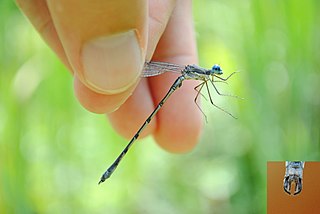
The sweetflag spreadwing is a species of damselfly in the family Lestidae, the spreadwings. It is native to North America, especially eastern parts of Canada and the United States.

Gomphurus externus, the plains clubtail, is a species of dragonfly in the family Gomphidae.

Lestes dryas is a species of damselfly in the family Lestidae, the spreadwings. Its common names include emerald spreadwing, scarce emerald damselfly and robust spreadwing. An alternate name in Ireland is the turlough spreadwing.

Onychogomphus uncatus, the large pincertail or blue-eyed hook-tailed dragonfly, is a species of dragonflies belonging to the family Gomphidae.
Burmagomphus pyramidalis, the sinuate clubtail, is a species of dragonfly in the family Gomphidae. It is found in India and Sri Lanka. There are 2 subspecies, where they are geographically separated.

Orthetrum testaceum, common names Crimson Dropwing or Orange Skimmer. is an Asian freshwater dragonfly species belonging to the family Libellulidae.

Microgomphus souteri is a species of small dragonfly in the family Gomphidae. It is endemic to the forest streams of Western Ghats of India.

Melligomphus acinaces is a species of dragonfly in the family Gomphidae. It is endemic to the streams of Western Ghats of India. This species was originally described as a Onychogomphus. However, both the pattern and the shape of the anal appendages do not fit Onychogomphus but are very close to those of the species placed in Melligomphus.

Lamelligomphus nilgiriensis is a species of dragonfly in the family Gomphidae. It is endemic to the hill streams of Western Ghats of India. This species has been placed by many authors in Onychogomphus but should be included in Lamelligomphus following Fraser (1934), based on the shape of the male anal appendages.

Merogomphus tamaracherriensis is a species of large dragonfly in the family Gomphidae. It is endemic to the forest streams of Western Ghats of India.

Nychogomphus striatus is a species of dragonfly in the family Gomphidae. It is endemic to the streams of Western Ghats of India. Reports from Nepal require further studies.
